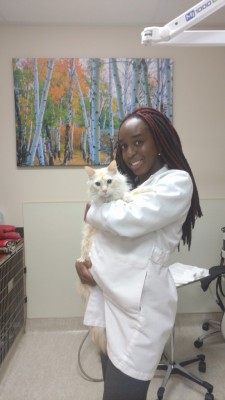Veterinarian Ukachi Ugorji D.V.M. of Craig Road Animal Hospital in North West Las Vegas identifies the causes and treatment of hairballs in cats.

By: Ukachi Ugorgi D.V.M.
Cats spend at least half of their waking hours licking themselves. They are trained to groom themselves from birth by watching their mothers. Cats lick themselves for several reasons aside from the obvious motive of hygiene. For them, grooming is a coping mechanism and form of self-comfort when they feel displaced or nervous. They also use grooming to regulate their body temperatures. The evaporation of saliva on their coats helps them to cool down in hot weather.
Cat tongues have tiny backwards-facing barbs that serve several purposes. The barbs (papillae) serve as the perfect grooming tool for your cat’s coat care. Their tongues are like a built-in comb that rakes their fur free of any dirt and debris. During this process, a cat’s free flowing hairs get raked up and can get swallowed.

Regular grooming is a very important role in managing hairballs.
Hairballs are an accumulation of free hair in the stomach. Generally, loose strands of hair pass through your cat’s digestive tract and are expelled in the feces. However, in some cases, the free hair that your cat swallows can get clumped together inside the stomach and is vomited up. Rare situations can result in a giant hairball called a trichobezoar.
A trichobezoar is a hard wad of hair that becomes lodged in the stomach that is too large to vomit or pass through the pylorus (opening of the stomach into small intestines). In extreme cases, hairballs can be fatal. If a cat is unable to pass the hairball, it can cause intestinal blockage that may require a gastro intestinal surgery to remove. Sluggishness, lack of appetite, and weight loss in your cat are all symptoms to cause alarm concerning your cat’s gastro-intestinal health. Speak with your veterinarian immediately if your cat won’t eat, or is retching and not producing anything.
To diagnose stomach or intestinal blockage a physical exam must first be performed by a Veterinarian. X-rays and ultrasound are methods by which your veterinarian can confirm that your pet has a blockage. After an ultrasound or X-ray reveals a blockage, depending on the location (stomach, esophagus, or intestine) and the size of the mass an endoscopy may be performed.
During this surgical procedure, a small tube with a camera attached is fed through the mouth and into the stomach to provide the surgeon with a view of the inside of the patient and remote grasping and loop tools are used to aid in the retrieval of the object. If the object, such as a hairball, cannot be removed by endoscopy then a full abdominal exploratory surgery may have to take place.

Hairballs, while relatively common, are not normal. There are a variety of underlying issues that can result in your cat vomiting up hairballs including stress, skin disease, allergies, parasites, and decreased motility of the gastro-intestinal tract.
Over-grooming is the most common cause of hairballs in cats. It is important to closely evaluate your cat’s environment for any causes of stress that could be compelling your cat to groom excessively. Note if there have been any recent changes in the household that could be triggering your cats, such as an addition of a new housemate or any unpleasant stimulus. Observe the interactions between your cat and the other members of the household to ensure that they are not stressful to your cat. Cats will also groom themselves out of boredom.
Ensure that your cat’s environment is enriched with toys to occupy themselves while they alone. Also, make sure they are getting enough attention and interactions while you are home.Hairballs can occur in long and short haired cats, although the problem is more persistent in cats with longer hair. It is especially important to maintain proper grooming and brushing to aid in the removal of loose hair in your cat’s coat. The more you aid in maintaining you cat’s coat the better you can prevent hairballs in your feline friend.Although hairballs are a natural part of a cat’s life cycle, they are not something that they have to suffer with if they become a problem. If you think your cat is having hairball issues you should discuss this with your Veterinarian.

